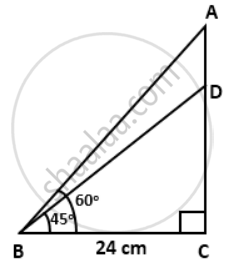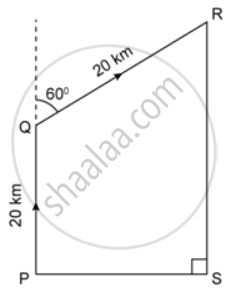Advertisements
Advertisements
Question
Find the length of AD. Given: ∠ABC = 60°, ∠DBC = 45° and BC = 24 cm.
Solution

In ΔABC,
tan60° = `"AC"/"BC"`
⇒ `sqrt(3) = "AC"/(24)`
⇒ AC = `24sqrt(3)"cm"`
In ΔDBC,
tan45° = `"DC"/"BC"`
⇒ 1 = `"DC"/(24)`
⇒ DC = 24cm
Now,
AC = AD + DC
⇒ AD
= AC - DC
= `24sqrt(3) - 24`
= `24(sqrt(3) - 1)"cm"`.
APPEARS IN
RELATED QUESTIONS
State for any acute angle θ whether tan θ increases or decreases as θ decreases.
Solve the following equation for A, if tan 3 A = 1
If sin 3A = 1 and 0 < A < 90°, find `tan^2A - (1)/(cos^2 "A")`
Evaluate the following: `((sin3θ - 2sin4θ))/((cos3θ - 2cos4θ))` when 2θ = 30°
If `sqrt(3)` sec 2θ = 2 and θ< 90°, find the value of
cos2 (30° + θ) + sin2 (45° - θ)
In the given figure, a rocket is fired vertically upwards from its launching pad P. It first rises 20 km vertically upwards and then 20 km at 60° to the vertical. PQ represents the first stage of the journey and QR the second. S is a point vertically below R on the horizontal level as P, find:
a. the height of the rocket when it is at point R.
b. the horizontal distance of point S from P.
Evaluate the following: cosec 54° - sec 36°
Evaluate the following: sin28° sec62° + tan49° tan41°
If cos3θ = sin(θ - 34°), find the value of θ if 3θ is an acute angle.
If tan4θ = cot(θ + 20°), find the value of θ if 4θ is an acute angle.
